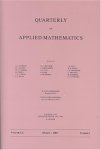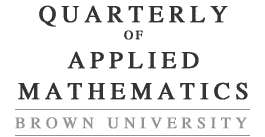Analysis of hysteretic reaction-diffusion systems
Authors:
Chichia Chiu and Noel Walkington
Journal:
Quart. Appl. Math. 56 (1998), 89-106
MSC:
Primary 92D25; Secondary 35K57, 47D06, 47N20
DOI:
https://doi.org/10.1090/qam/1604805
MathSciNet review:
MR1604805
Full-text PDF Free Access
Abstract |
References |
Similar Articles |
Additional Information
Abstract: In this paper, we consider a mathematical model motivated by patterned growth of bacteria. The model is a system of differential equations that consists of two sub-systems. One is a system of ordinary differential equations and the other one is a reaction-diffusion system. Pattern formation in this model is caused by an initial instability of the ordinary differential equations. However, nonlinear coupling to the reaction-diffusion system stabilizes the ordinary differential equations resulting in stationary long-time behavior. We establish existence, uniqueness, and characterize long-time behavior of the solutions.
- N. F. Britton, Reaction-diffusion equations and their applications to biology, Academic Press, Inc. [Harcourt Brace Jovanovich, Publishers], London, 1986. MR 866143
- E. O. Budriené, A. A. Polezhaev, and M. O. Ptitsyn, Mathematical modelling of intercellular regulation causing the formation of spatial structures in bacterial colonies, J. Theoret. Biol. 135 (1988), no. 3, 323–341. MR 971888, DOI https://doi.org/10.1016/S0022-5193%2888%2980248-0
- Jerome A. Goldstein, Semigroups of linear operators and applications, Oxford Mathematical Monographs, The Clarendon Press, Oxford University Press, New York, 1985. MR 790497
C. Chiu, F. C. Hoppensteadt, and W. Jäger, Analysis and computer simulation of accretion patterns in bacterial cultures, to appear
- Chichia Chiu and Noel Walkington, An ADI method for hysteretic reaction-diffusion systems, SIAM J. Numer. Anal. 34 (1997), no. 3, 1185–1206. MR 1451120, DOI https://doi.org/10.1137/S0036142994270181
- F. C. Hoppensteadt and W. Jäger, Pattern formation by bacteria, Biological growth and spread (Proc. Conf., Heidelberg, 1979) Lecture Notes in Biomath., vol. 38, Springer, Berlin-New York, 1980, pp. 68–81. MR 609347
- F. C. Hoppensteadt, W. Jäger, and C. Pöppe, A hysteresis model for bacterial growth patterns, Modelling of patterns in space and time (Heidelberg, 1983) Lecture Notes in Biomath., vol. 55, Springer, Berlin, 1984, pp. 123–134. MR 813709, DOI https://doi.org/10.1007/978-3-642-45589-6_11
G. Hauser, Uber Fäulnisslacterien und deren Beriehungen zur Septicämie, Leipzig: F. G. W. Vogel, 1885
U. Hornung and R. E. Showalter, Pde-models with hysteresis on the boundary, in A. Visintin, editor, Models of Hysteresis, volume 286, Research Notes in Mathematics, Pitman, 1983, pp. 30–38
- Ulrich Hornung and R. E. Showalter, Elliptic-parabolic equations with hysteresis boundary conditions, SIAM J. Math. Anal. 26 (1995), no. 4, 775–790. MR 1338362, DOI https://doi.org/10.1137/S0036141093228290
D. L. Lewis and D. K. Gattie, The ecology of quiescent microbes, ASM News 57, 27–32 (1991)
P. Gerhardt, et al., Manual of Methods for General Bacteriology, P. Gerhardt, editor-in-chief, Amer. Soc. for Microbiology, Washington, DC 20006, 1981
- H. Melvin Lieberstein, Theory of partial differential equations, Academic Press, New York-London, 1972. Mathematics in Science and Engineering, Vol. 93. MR 0355280
- T. D. Little and R. E. Showalter, Semilinear parabolic equations with Preisach hysteresis, Differential Integral Equations 7 (1994), no. 3-4, 1021–1040. MR 1270116
J. W. T. Wimpenney, J. P. Coombs, R. W. Lovitt, and S. G. Whittaker, A gel-stabilized model ecosystem for investigating microbial growth in spatially ordered solute gradients, J. Gen. Microbio. 127, 277–287 (1981)
- Jack W. Macki, Paolo Nistri, and Pietro Zecca, Mathematical models for hysteresis, SIAM Rev. 35 (1993), no. 1, 94–123. MR 1207799, DOI https://doi.org/10.1137/1035005
J. Monod, Recherches sur La Croissance de Cultures Bacteriennes, Hermann et Cie, Paris, 1942
- J. D. Murray, Mathematical biology, Biomathematics, vol. 19, Springer-Verlag, Berlin, 1989. MR 1007836
T. E. Shehata and A. G. Marr, Synchronous growth of enteric bacteria, J. Bacteriology 103, 789 (1970)
N. E. Britton, Reaction-Diffusion Equations and Their Applications to Biology, Academic Press, New York, 1986
E. O. Budriené, A. A. Polezhaev, and M. O. Ptitsyn, Mathematical modeling of intercellular regulation causing the formation of spatial structures in bacterial colonies, J. Theor. Biol. 135, 323–341 (1988)
J. A. Goldstein, Semigroups of Linear Operators and Applications, Oxford Mathematical Monographs, The Clarendon Press, Oxford University Press, New York, 1985
C. Chiu, F. C. Hoppensteadt, and W. Jäger, Analysis and computer simulation of accretion patterns in bacterial cultures, to appear
C. Chiu and N. J. Walkington, An ADI method for hysteretic reaction-diffusion systems, SIAM J. Numer. Anal. 34, 1185–1206 (1997)
F. C. Hoppensteadt and W. Jäger, Pattern formation by bacteria, Lecture Notes in Biomath. 38, 68–81 (1980)
F. C. Hoppensteadt, W. Jäger, and C. Pöppe, A hysteresis model for bacterial growth patterns, in Modelling of Patterns in Space and Time, W. Jäger and J. D. Murray, eds., Lecture Notes in Biomath. vol. 55, Springer-Verlag, Berlin, New York, 1984, pp. 123–134
G. Hauser, Uber Fäulnisslacterien und deren Beriehungen zur Septicämie, Leipzig: F. G. W. Vogel, 1885
U. Hornung and R. E. Showalter, Pde-models with hysteresis on the boundary, in A. Visintin, editor, Models of Hysteresis, volume 286, Research Notes in Mathematics, Pitman, 1983, pp. 30–38
U. Hornung and R. E. Showalter, Elliptic-parabolic equations with hysteresis boundary conditions, SIAM J. Mathematical Analysis 26, 775–790 (1995)
D. L. Lewis and D. K. Gattie, The ecology of quiescent microbes, ASM News 57, 27–32 (1991)
P. Gerhardt, et al., Manual of Methods for General Bacteriology, P. Gerhardt, editor-in-chief, Amer. Soc. for Microbiology, Washington, DC 20006, 1981
H. M. Lieberstein, Theory of Partial Differential Equations, Mathematics in Science and Engineering, vol. 93, Academic Press, New York and London, 1972
T. D. Little and R. E. Showalter, Semilinear parabolic equations with Preisach hysteresis, Differential and Integral Equations 7, 1021–1040 (1994)
J. W. T. Wimpenney, J. P. Coombs, R. W. Lovitt, and S. G. Whittaker, A gel-stabilized model ecosystem for investigating microbial growth in spatially ordered solute gradients, J. Gen. Microbio. 127, 277–287 (1981)
J. W. Macki, P. Nistri, and P. Zecca, Mathematical Models for Hysteresis, SIAM Review, Vol. 35, No. 1, 1993, pp. 94–123
J. Monod, Recherches sur La Croissance de Cultures Bacteriennes, Hermann et Cie, Paris, 1942
J. D. Murray, Mathematical Biology, Biomathematics Texts, Springer-Verlag, 1989
T. E. Shehata and A. G. Marr, Synchronous growth of enteric bacteria, J. Bacteriology 103, 789 (1970)
Similar Articles
Retrieve articles in Quarterly of Applied Mathematics
with MSC:
92D25,
35K57,
47D06,
47N20
Retrieve articles in all journals
with MSC:
92D25,
35K57,
47D06,
47N20
Additional Information
Article copyright:
© Copyright 1998
American Mathematical Society



